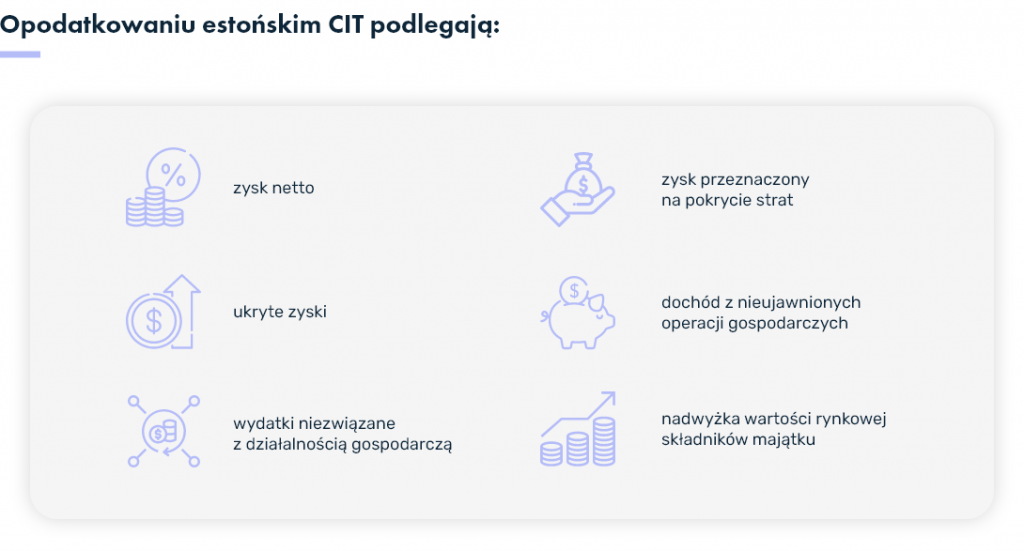Estonian CIT – what is it?
If you run a business as a legal entity, and therefore pay CIT on a regular basis, you have surely already heard the term “Estonian CIT.” You may also have received information according to which Polish entrepreneurs from 2021 have the opportunity to switch to Estonian CIT, and that such a change may prove to be very beneficial for business conducted. Theory and announcements are one thing, but practice has shown that few companies have benefited from the first version of Estonia’s CIT.
A lot of restrictions and the complexity of the regulations made most entrepreneurs decide to wait. As it turned out later – rightly so, because the next version of the regulations was already much more friendly. And – according to the announcements of the Ministry of Finance – it doesn’t stop there.
Estonia’s corporate income tax operates on a flat rate basis on corporate income. What features of it are particularly attractive to entrepreneurs?
Less accounting
One of the strengths of the Estonian CIT, particularly appreciated by companies, is the smaller share of accounting in the day-to-day running of the business.
A company that decides to settle accounts with the tax office using Estonian CIT settlement is not required to perform three onerous steps that are the order of the day for Polish CIT payers. It is about:
- keeping tax accounts,
- Determining tax deductible expenses,
- Calculation of tax depreciation allowances.
Choosing the moment of taxation
Another equally important distinctive feature of the Estonian CIT is the possibility of deferring the moment when the tax liability arises. Usually, when a company generates a profit, it is required to pay tax in the next accounting period – usually a month, less often a quarter. Using the solution popularized in Estonia, entrepreneurs can spend the income they earn before taxes – for example, on modernizing machinery, courses and training for staff, introducing new technologies, building a new warehouse, office or other investments.
What happens to the CIT tax due? This one should be paid only at the time when the company’s representatives decide to distribute profits to shareholders. This makes the Estonian CIT the best option for companies that invest a lot and regularly, and rarely choose to distribute profits from the company. Until that moment happens, the company will de facto not pay any tax.
In a nutshell, this means that companies using Estonian CIT are free to choose their tax timing according to their needs.
Estonian CIT – effective tax rate
This is not the end of the advantages that the Estonian CIT brings. Although the tax may initially appear higher, the effective total taxation compares favorably to paying a traditional CIT. This is because a partner of a company benefiting from Estonian CIT can reduce the amount of PIT due from the distribution by the portion of CIT already paid by the company. Let’s see how the case presents itself with specific examples:
If you are a small CIT taxpayer:
| Traditional CIT/PIT | Estonian CIT |
| The taxpayer pays 9% CIT, but as much as 19% tax on dividends. With the company’s net profit of PLN 500,000, the taxpayer pays PLN 45,000 in tax and dividends of PLN 455,000. Tax of PLN 86,450 must be paid on the dividend paid. The total tax value is therefore 131,450 zlotys, (or 26.29%). | The taxpayer pays 10% of the CIT, but only 10% of the dividend tax (if 90% of the CIT is deductible). With the company’s net profit of PLN 500,000, the taxpayer has to bear in mind the CIT (10%), but can still pay a dividend of PLN 500,000. Tax has to be paid on this dividend (again, 10%). All of this adds up to a total tax bill of PLN 100,000 (20%). |
If you are not a small CIT taxpayer:
| Traditional CIT/PIT | Estonian CIT |
| The taxpayer must pay an advance CIT tax of 19%. The same tax will be paid on dividends. If the company’s net profit is PLN 2,000,000, the taxpayer must pay as much as PLN 380,000 in tax. The possible dividend to be paid is PLN 1,620,000. The tax on it amounts to PLN 307,800. This actually gives an amount of PLN 1,312,200 available. The total amount of tax is PLN 687,800, which is as much as 34.39% of the effective tax. | The Estonian CIT makes the taxpayer pay 19% tax on income, but only 5% tax on dividends! In the example discussed next (PLN 2,000,000 net profit), the taxpayer will have to pay PLN 360,000 in tax. With a dividend payment of PLN 2,000,000, the dividend tax will be PLN 100,000. The total amount of tax in this option is PLN 460,000. This amount is equal to 25% of the value of the net profit. |
Estonian CIT – for whom?
It is worth distinguishing first between the two periods of Estonian CIT’s operation in Poland. Initially, for example, at the end of 2020, only joint-stock and limited liability companies could benefit from this form of taxation. Other restrictions were also in place, such as a revenue limit of PLN 100,000,000 per year (including VAT).
As of the beginning of 2022, the rules of Estonian CIT in Poland have strongly changed, allowing many more companies to benefit from this form of taxation. That still wasn’t enough, however, and a number of modifications were made in January 2023, one of the most important of which is simplification. What are the current rules of the Estonian tax?
Who can switch to Estonian CIT?
The Estonian CIT can be used:
- joint stock companies;
- limited partnerships;
- limited joint-stock partnerships;
- simple joint stock companies;
- limited liability company.
If an entrepreneur operates another type of company and wants to start benefiting from Estonian CIT, he or she must first convert the company into one of the forms listed above.
Transformation tax and how to avoid it
Changing the legal form of a company to switch to Estonian CIT is not without consequences. One of the most significant is the so-called. transformation tax. This means that the entrepreneur must determine the amount of income from the conversion, i.e. the difference between the accounting and tax value of the company’s assets.
The tax on the conversion is paid only once, in the first tax year following the company’s conversion and change of taxation form to Estonian CIT. This is a positive circumstance, as entrepreneurs can use it to their advantage.
The recipe for a transformation tax is to follow these few steps:
Additional conditions for taxpayers settling Estonian CIT.
However, there are additional conditions that a company must meet in order to be accounted for through Estonian CIT. A taxpayer interested in switching to the Estonian tax, must ensure that:
- partners, shareholders and stockholders of the company are only natural persons;
- the company derives no more than 50% of its income from interest, loans, lease payments, receivables, copyrights or industrial property, as well as transactions with related parties, warranties or guarantees;
- the taxpayer does not have:
- shares of other companies;
- participation in an investment fund or mutual institution;
- The company does not prepare financial statements for the flat tax period;
- employs:
- at least 3 people for at least 300 days in the fiscal year on an employment contract,
- or employs workers on a type of contract other than the UoP. In the latter case, however, it is important to note that the employer is required to spend at least three times the average monthly salary in the enterprise sector on salaries – as long as the taxpayer is required to collect advance payments for PIT and Social Security in connection with the payment of these salaries.
Important!
If the fiscal year is a period other than consecutive 12 calendar months, the obligation to employ at least 3 people for at least 300 days in a fiscal year would not hold true, so the appropriate percentage conversion is applied. Estonian CIT taxpayers must therefore employ workers for at least 82% of the days in a part-year tax period.
The condition regarding the required form of employment changed in January 2023. The reason for the modification was the problems encountered by entrepreneurs wishing to take advantage of the Estonian CIT in situations where they employed persons covered by the PIT exemption (for example, persons under 26 years of age). This is because previous provisions stated that the taxpayer had to be both the payer of tax and the payer of contributions on employees’ salaries. The lack of tax to be paid prevented the use of Estonian CIT before the amendment.
In addition, a representative of a company that wishes to take advantage of the Estonian CIT must file a notice of election of lump-sum taxation with the head of the relevant US (form ZAW-RD). This notice can be submitted by the end of the first month of the tax year in which you want to tax your income in a lump sum.
New company and Estonian CIT
Those starting a business, can benefit from the Estonian CIT. Moreover, some simplifications are provided for them. One of them is that the revenue condition is automatically considered to be met in the first year of the company’s operation.
New companies also do not have to hire three employees right away. Under current regulations, a new entrepreneur has more time to achieve this level of employment – this condition in its typical form does not apply to the start-up year or the following two years. Instead, the new companies are required to gradually increase employment. In the second fiscal year, employment should increase by at least one FTE, in the next year by one more, until in the third year of operation it reaches the level stipulated by the law (three FTEs).
Estonian CIT – who can’t use this option?
Even if a company meets all of the conditions listed above, it will not be eligible for Estonian CIT taxation if at least one of the listed elements applies to it:
- Is a financial enterprise (bank, savings bank, factor);
- Is a lending institution;
- Is in bankruptcy or liquidation;
- operates in a special economic zone;
- It was formed as a result of a merger or demerger;
- It was divided by separation.
How to switch to Estonian CIT?
Do you meet all the conditions and want to switch to Estonian CIT? Here’s what you need to do!
At the beginning of the fiscal year
If you want to start accounting for Estonian tax from the beginning of the tax year, all you need to do is file a notice of choice of Estonian CIT as a form of taxation. This notice must go to the appropriate head of the tax office.
During the fiscal year
However, if you plan to make this change while the fiscal year is already underway, you need to prepare first:
Estonian CIT and the New Deal
It was the tax changes envisioned by the New Deal program that made the use of Estonian tax in Poland simpler and accessible to a wider range of taxpayers. What does the Estonian CIT 2.0 change?
- More types of companies can benefit from Estonian CIT;
- The need for capital expenditures has been removed;
- the annual revenue limit, which until the end of 2021 was PLN 100,000,000 per year (this amount has so far included VAT), no longer applies.
Thus, for entrepreneurs interested in switching to Estonian CIT, these are unequivocally positive changes – Estonian CIT from 2023 is even easier to access, and less subject to restrictions.
Estonian CIT – terms, conditions, law
The reader can find more detailed terms of the Estonian CIT in a document with the graceful title: Law of November 28, 2020. On amending the Law on Corporate Income Tax and certain other laws.
What else is worth remembering?
What is subject to CIT?
Not only is the company’s net profit and dividends generated by the company subject to Estonian CIT (as shown in the examples above), but also the so-called “dividends”. hidden profits, i.e.: monetary and non-monetary benefits, gratuitous and partially gratuitous benefits, or benefits performed for the benefit of shareholders or partners (e.g., loans).
Also taxed are non-business expenses and the excess of the market value of the assets acquired or contributed in kind over the value of the components in the case of mergers, demergers, conversions of entities or contributions.
At this point, it is worth mentioning that expenses, depreciation and impairment charges that are related to the use of vehicles and other assets exclusively for business purposes do not count in this group – so they are treated as business expenses and are not taxable. If the same expenses and write-offs apply to assets used in mixed operations, 50% of them are subject to Estonian CIT.
Important!
It is the taxpayer’s responsibility to show which expenses meet the condition of business connection.

Employment criteria
We mentioned that a taxpayer who wants to take advantage of the Estonian CIT must employ at least three people under employment contracts. In this context, it is worth remembering two important elements.
First: the three people mentioned in the CIT Law refer to full-time equivalents – this means that a company can employ, for example, six people – each part-time.
Moreover, the taxpayer must ensure that the salary expenses of employees working under a contract other than an employment contract are no less than three times the average salary. This refers to the average monthly salary in the corporate sector (this provision was clarified in January 2023), which means that a company benefiting from the Estonian CIT in 2023 is required to guarantee employees’ salaries of at least PLN 20,218.26 in total.
This amount is due to the fact that for the purposes of the law, remuneration including profit distributions in the third quarter of the calendar year preceding the first day of the tax year is taken into account (this is stated in Article 28c, item 2a of the CIT Law).
Rules for accounting for expenses
The rules for accounting for expenses have changed. Under the new regulations, 50% of the costs for passenger cars are considered non-business expenses if the vehicle is also used for private purposes. These expenses are subject to Estonian CIT, which means entrepreneurs will pay more.
Loss of right to Estonian CIT
You can lose the right to benefit from Estonian CIT in the classic way, i.e. by filing a notice of resignation, but also as a result of failure to meet the prerequisites, improper maintenance of tax books or acquisition of another entity.
Once you lose the right to Estonian CIT, you can apply for re-taxation under Estonian rules after 3 years, counting from the end of the calendar year.
A choice for years to come
A taxpayer who decides to switch to Estonian CIT will be obliged to use these rules for four calendar years. If the company’s management does not decide to resign from this form of taxation, accounting with Estonian CIT will be extended for another four years.
That’s it for the Estonian corporate income tax. We hope that this guide has introduced you to the idea of using Estonian CIT and will help you decide: to switch to Estonian CIT, or to stay with the traditional solution for the time being. The decision is up to your company!


